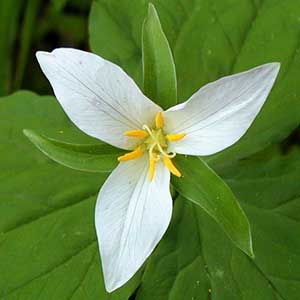Trillium ovatum
Trillium angustipetalum
Pacific trillium, trillium, western trillium, western wake-robin, western white trillium, white or western trillium, white trillium
giant purple wakerobin, narrow petal wakerobin, narrow-petal trillium
semierect to horizontal, short, stout, praemorse.
erect, brownish, thick, somewhat compressed-thickened, praemorse, not brittle.
1–2, round, 2–5 dm, ± slender, glabrous.
1–2, round in cross section, 2.5–6 dm.
sessile, subsessile, or short-petiolate;
blade medium green, sometimes blotched and mottled, main veins prominent, ovate-rhombic, 7–12 × 5–20 cm, continuing to expand during anthesis, base rounded, apex acuminate.
held well above ground, spreading horizontally, subsessile;
blade very sparsely mottled with dark greenish brown or rarely all green, mottling becoming obscure with age, broadly ovate, 10–22 × 8.7–15 cm, not glossy, often narrowed to falsely petiolate, very short, and narrowly cuneate base 10–20 mm, apex obtuse.
erect or nodding, odorless;
sepals spreading to horizontal, green, lanceolate to oblong-lanceolate, 15–50 × 6–20 mm, margins entire, apex acute;
petals erect-ascending, usually wide-spreading from base, exposing entire pistil, white or with pink or blush markings, lacking V-shaped markings, fading to rosy pink, purple, or dark red, veins not deeply engraved, ± linear to widely obovate, 1.5–7 ×1–4 cm, widest at or above middle, thin-textured, margins flat to undulate, apex acuminate;
stamens prominent, slightly recurved-spreading to straight, 10–18 mm;
filaments white, shorter than anthers, slender;
anthers yellow, 4–16 mm, slender, dehiscence latrorse-introrse;
ovary green or white, ovoid, 6-angled, 5–12 mm, attachment ± 3/4 ovary width;
stigmas recurved, barely connate basally, greenish white or white, linear, not lobed adaxially, 6–10 mm, uniformly thin;
pedicel erect to leaning, 2–6 cm.
erect, odor spicy-musty, musty, or fetid;
sepals conspicuous, spreading, often resting on bracts, maroon to green, linear to oblong-lanceolate, 35–47 × 8–10 mm, margins flat, entire, apex acute;
petals long-lasting, erect, ± connivent, ± concealing stamens and ovary and partially obscuring stamens, dark purple to red-purple, not spirally twisted, veins obscure, linear, 5–10 × 0.7–1.4 cm, 8–10 times longer than wide, glossy, thick-textured, base linear, margins entire, at first flat but inrolling with age, apex variously acute-obtuse;
stamens erect, 12–22 mm;
filaments dark maroon, 2–4 mm, slender, widest at base;
anthers erect, straight, purple, 12–18 mm, dehiscence introrse;
connectives purple, slightly extended 1–1.5 mm beyond anther sacs;
ovary dark, ovoid-ellipsoid, 6-angled toward apex, 7.5–12 mm;
stigmas erect, divergent-recurved, distinct, purple, sessile, awl-shaped, thickly subulate, 5 mm, thick, fleshy.
baccate, green or white, ± odorless, broadly ovoid, obscurely winged, 1.2–2.8 × 0.7–1.9 cm, pulpy-moist.
dark purple, fragrance unknown, subglobose, 6-angled, almost winged, fleshy.
= 10.
= 10.
Trillium ovatum
Trillium angustipetalum
Varieties 2 (2 in the flora).
(Discussion copyrighted by Flora of North America; reprinted with permission.)
Trillium angustipetalum occurs in the Sierra Nevada from Fresno County north to Placer County (J. D. Freeman 1975). It is disjunct in the coastal mountains and hills of Santa Barbara and San Luis Obispo counties.
B. D. Ness (1993) listed Trillium kurabayashii as a synonym of T. angustipetalum. In bract orientation, color, and texture, and in petal shape, the two are quite different and certainly not the same species. Cytologist Masataka Kurabayashi found chromosomal differences between the two species (reported by J. D. Freeman 1975).
(Discussion copyrighted by Flora of North America; reprinted with permission.)
1. Bracts sessile; petals lanceolate to obovate, 1.5–7 × 1–4 cm | var. ovatum |
1. Bracts distinctly short-petiolate; petals linear to linear-lanceolate, 0.5–2.4 × 0.2–0.6 cm | var. oettingeri |
- Local floras:
BC,
CA,
OR,
WA
- Local Web sites:
CalFlora,
CalPhotos,
Flora NW,
PNW Herbaria,
Turner Photog.
WildflowerSearch
iNaturalist (observations)
USDA Plants Database
- LBJ Wildflower Center
- SEINet
- Plants of the World Online
- Encyclopedia of Life
- Wikipedia
- Google Image Search


